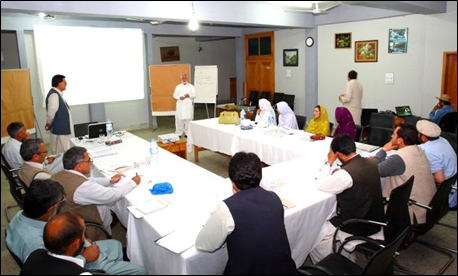Vulnerability assessments for integrated bottom-up planning
Orientation of government staff on the concept and approaches of biodiversity conservation and tools & techniques for climate sensitive vulnerability assessment
GIZ
The project developed and applied a tool for the assessment of vulnerabilities of communities and ecosystems towards the impacts of climate change. The aim was to ensure that the measures implemented reflect the priorities of the community and, at the same time, consider the local climate. After orientations on general climate change vulnerabilities in Pakistan, the vulnerability assessments (VAs) were implemented by teams of agricultural and forestry experts from various government departments, along with project staff.
The teams applied different Participatory Rural Appraisal (PRA) techniques, including key informant discussions, focus group discussions (FGDs), village resource mapping, transect walks, and field observations.
Information was collected on general village issues as well as on main natural hazards and their impacts. Based on the vulnerability assessment and consultations with the pilot communities, a set of adaptation measures were identified. The communities have been fully involved in all steps.
• A consulting firm was contracted for backstopping and support to district teams.
• The assessment was based on an existing methodology (GIZ’s Vulnerability Sourcebook.
• An orientation workshop for key stakeholders followed by training for District staff was organized to share the VA approach and to enhance capacities of key stakeholders and discuss data needs/ sources.
• Community awareness, mobilization and involvement
• Active participation of the government line agencies (departments)
• Local-level VAs are an important tool for integrated bottom-up planning. They help to identify socially-acceptable and biodiversity friendly measures that support adaption to climate change. The government should consider making VAs mandatory so that values and services of biodiversity can be safeguarded.
• Gender aspects of the VAs should be worked out according to the local customs and traditions to allow women participation in the assessments. This is particularly important when women are involved in managing the natural resources.
• The assessment proved very helpful for the local communities as well as the line agencies to understand the scale and type of their vulnerabilities with regard to climate change. The realization paved the way for effective implementation of the climate change adaptation measures.
• The PRA tools can vary from one community to another, so judicious thought is necessary when selecting the tools. The tools should be context and culture sensitive.

